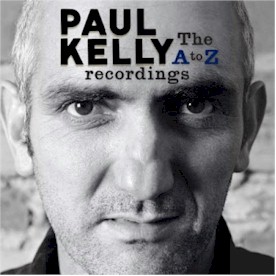 Paul Kelly is a national treasure; it’s just a shame he’s not our nation’s to claim. He’s Australian—born in Adelaide, living in Melbourne, and exporting his wonderful songs to a planet’s worth of fans in albums like 1987’s Under the Sun (which featured “Dumb Things,” his first quasi-hit in America), 1991’s packed Comedy, and 2004’s Tchad Blake-produced double album Ways and Means.
Paul Kelly is a national treasure; it’s just a shame he’s not our nation’s to claim. He’s Australian—born in Adelaide, living in Melbourne, and exporting his wonderful songs to a planet’s worth of fans in albums like 1987’s Under the Sun (which featured “Dumb Things,” his first quasi-hit in America), 1991’s packed Comedy, and 2004’s Tchad Blake-produced double album Ways and Means.
In 2010, he released a box set in his native land—an eight-disc compilation culling live takes of 105 of his best and best-known songs, arranged, oddly enough, in alphabetical order. A—to—Z Recordings emerged out of a series of live shows Kelly had performed since 2004 with the same conceit—multiple-night, career-spanning gigs, with songs played in A-to-Z order. The box had an accompanying book called How to Make Gravy (after one of his most beloved songs)—an over-500-page tome containing the stories behind each track, in effect forming the largest set of liner notes you’ve ever read. The two projects, taken together, are a primer on great songwriting—if you’re a songwriter or wish to become a songwriter, you simply must hear these songs, to hear how the one of the best plies his craft.
The box and book saw their U.S. release back in March, and Kelly did a short run of A—to—Z shows in the States to promote them. Since then, his mid-tour performance on the public radio program Mountain Stage Live has aired (you’ll be able to hear a stream of it on NPR Music, starting May 20). A reissue campaign will kick off July 17, with three great titles—the addiction-obsessed Post (1985), the aforementioned Comedy, and 1994’s Wanted Man (which features my favorite Kelly song, “Love Never Runs on Time”)—back in print. Finally, Paul Kelly fans will rejoice at the news that November will see the release of a brand new Paul Kelly studio album, his first in five years.
I spoke with Kelly at the beginning of his spring tour. He was in Austin, TX, shortly before soundcheck for that night’s performance.
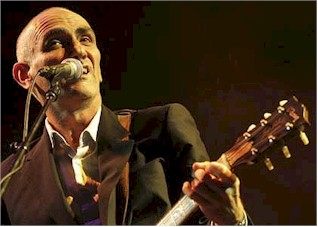 Congratulations on the box set and the book. It’s really impressive stuff—eight CDs, 500-plus pages. There aren’t that many people who could pull that off as successfully as you’ve done. Tell me a bit about how it all came about, how you decided to approach the project this way.
Congratulations on the box set and the book. It’s really impressive stuff—eight CDs, 500-plus pages. There aren’t that many people who could pull that off as successfully as you’ve done. Tell me a bit about how it all came about, how you decided to approach the project this way.
I really didn’t know what I was doing from the start; I never imagined what it would roll into, something so large. It all started with me doing a series of four nights at a venue in Melbourne. I decided to do something different and perform 100 songs in alphabetical order, over those four nights. Each night would be a different set list, a different pace. I thought that would be a one-off event. And I realized after I’d done the first one, that this would be the kind of thing I could keep coming back to—it was a new way of doing songs and it sort of sidestepped the eternal performance dilemma of putting together a show, of balancing your old and your new material.
Right.
It took all that out of the equation. I didn’t even think in terms of old or new, because the set was ruled by the alphabet. It gave me a new way to structure shows and it gave the audience a different way to come and listen. It changed the audience’s expectations. I realized I was onto something there, and it also put me back in touch with a lot of my songs that I hadn’t played much, for no good reason other than when you’re putting together a 75-minute or a 90-minute show, you have other things you’re thinking about—the structure, the dynamics, the pacing. You have certain songs that have always worked at various points in the set, so you tend to use them. I found out that over the years I would vary songs in shows and on tours, even when being conscious of that, there were some songs that just never got a run. It brought all those songs back into play. It made performing fresh again.
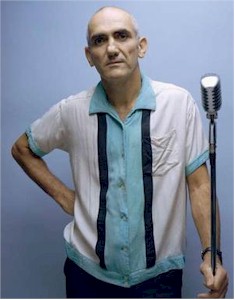 So I thought it would be a one-off, but I decided to keep doing this, and I kept doing these series of shows once or twice a year. And I recorded them, and I thought after a while I could put them out as a series of recordings. My next thought was, if I was going to put out a hundred songs or so, which I knew would be a lot of CDs, I should make a really beautiful object out of it. I didn’t want to just stick the CDs in plastic covers. I thought I’d include some liner notes and pictures and such. My idea for the notes was to tell stories around the songs, talk about influences, whatever. I started with the very first song, which was “Adelaide,” and I wrote ten pages on it! A little light bulb went off in my head, and I thought, “Ah, if I keep doing this, I could have a book.”
So I thought it would be a one-off, but I decided to keep doing this, and I kept doing these series of shows once or twice a year. And I recorded them, and I thought after a while I could put them out as a series of recordings. My next thought was, if I was going to put out a hundred songs or so, which I knew would be a lot of CDs, I should make a really beautiful object out of it. I didn’t want to just stick the CDs in plastic covers. I thought I’d include some liner notes and pictures and such. My idea for the notes was to tell stories around the songs, talk about influences, whatever. I started with the very first song, which was “Adelaide,” and I wrote ten pages on it! A little light bulb went off in my head, and I thought, “Ah, if I keep doing this, I could have a book.”
I carried on for a while, not knowing whether I’d be able to sustain it. After a while I realized if I kept at it, I really could make a book. I put touring aside for a couple years and the rest is history.
That’s wonderful.
The book came out in Australia at the end of 2010, and I started doing more A-to-Z shows, to tie in with the book and all that. Then we stepped it up. We brought the first A-to-Z shows to the States the next September, but we didn’t have much time. We booked a few cities, and now we’re back on a second run.
I remember reading about the project on your Web site, when it came out in Australia, and hoping it would come out here. It’s great that your fans here in the States can get it now. What was your criteria for selecting songs for the box? Of course, there are always going to be songs that people love that didn’t make the cut.
What was selected for the box set in the end was based on what was in the book, and what was in the book was really songs that I wanted to write about—each time I would sit down to write, I’d focus on one song. Sometimes I’d select a song and sit down and not have anything to write about, or couldn’t find a way into writing about it, so I’d just set it aside and move onto the next one. But I wanted the box set to mirror the book, so in the end, that’s how I chose songs for the box.
I wound up recording about 140 songs or so. It’s not like I left a lot of songs out, because 105 songs is a lot anyway. I’ve probably written about 300 songs in 35 years, plus, you know, co-writes, or songs that didn’t quite translate with the band. These songs have pretty much all been acoustic, either solo or with my nephew, Dan Kelly—that’s the way they work. So as it is I probably have about 150 songs in play that I can still connect with. But those 105 songs in the box set were the ones I could write some prose about.
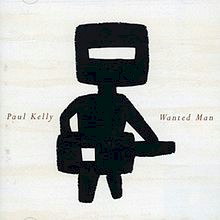 I’ve been telling people that if you’re a songwriter, you have to listen to this box—it’s like a clinic of great songwriting. Do you feel a sense of accomplishment when you consider the work you’ve done here?
I’ve been telling people that if you’re a songwriter, you have to listen to this box—it’s like a clinic of great songwriting. Do you feel a sense of accomplishment when you consider the work you’ve done here?
I think I felt that more about writing the book, because that’s new for me; I never thought I’d write a book. I’ve always thought of myself as a writer, but one who writes songs; to write the book was definitely an accomplishment. By the time I finished the book and got the book and the box set out, I felt like I’d been looking back for a long time. I’d always felt rather useful when I wrote a new song, no matter how many songs I’d written. I’ve always wanted to write the next song; I don’t want to write the next book, but I want to write the next song. The thought is, you’re only as good as your last song.
[Laughs] That’s not true.
Yeah, but when I wrote the book—in the three years it took me to write it, I didn’t write a song in that time. It wasn’t a choice; it’s just the way it happened. It was like flipping a switch; I would sit down every day at the desk to write the book—I tried to do that every day—and I just didn’t write songs. Then, of course, the book came out and there was a fit of promotion around that and touring and A-to-Z shows. So it took four years between writing songs. I finally got back around to scratching out a few songs last year, and I’ve written a few more this year, and I’ll start recording in July. I’m really ready to start doing something new.
Was it just a matter of time or creative energy that kept you from writing, or a little bit of everything?
No, it was just time. It was having the time.
You’ve been writing songs since your early twenties, and I’m curious, since you’ve had to look back for this project, do you remember what led you to want to create something new, instead of simply playing other people’s material?
That was always what I wanted to do, from the first. I wanted to be a writer, since I was about the age of 15. Like a lot of people, I wrote poetry when I was 15 or 16. Then I just kept going; I wrote a lot of short stories, or sort of prose poems. So I had it in my head to be a writer. And then, I picked up the guitar around the age of 18. I started learning songs, of course, and I wrote my first song when I was 21. So, I guess I’ve always thought of myself as a writer first, and not a performer. I never thought of myself as competing against great singers or great performers. For me, it was the writing first. I started performing because I wrote things.
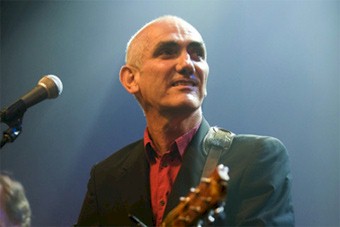 I was listening to So Much Water So Close to Home in the car this morning, and “The Most Wanted Man in the World” came on, and it occurred to me that it sounds like an old Stax/Volt song, in the melody and the way that it’s structured. What did you listen to growing up? What was the radio like in Australia when you were a kid?
I was listening to So Much Water So Close to Home in the car this morning, and “The Most Wanted Man in the World” came on, and it occurred to me that it sounds like an old Stax/Volt song, in the melody and the way that it’s structured. What did you listen to growing up? What was the radio like in Australia when you were a kid?
Well you’re right with the Stax/Volt thing; that was me trying to write a Spooner Oldham song, you know? It wasn’t much about the radio, though. In my late teens, I was trying to figure out music, and one thing just led to another. I discovered soul music, things like James Carr, “Dark End of the Street” and songs like that.
Absolutely. I hear a lot of American influences.
Yeah. A lot [laughs]. It’s a huge well of incredible music. It’s always been the kind of stuff I listen to. The Stanley Brothers, the Louvin Brothers, Bill Monroe, or —
You’ve done some bluegrass music, too.
Yeah, but it’s also things like John Lee Hooker. All those rivers of music were ones I would jump into. In Australia, we also had a lot of our own bands and British influences as well. In the early Eighties, I was really trying to get a handle on some of the Australian bands like the Saints and the Triffids and the Go-Betweens.
Was the touring circuit in Australia as tough as we’ve heard about it here? I remember reading about bands like AC/DC having to practically fight their way out of clubs some nights. Was it as rough an audience as it was made out to be?
I’m sure some of those stories have been exaggerated. We had what was called a pub rock culture. I wouldn’t say it was a tough thing; I would say it was a great thing. It was a way for bands to cut their teeth. Sure, you’re playing in a pub, you’re playing to people drinking, and you’ve got to cut through that. But when you start playing, you’re playing through a lot of background noise—glasses clinking and people drinking and talking, people who are either picking each other up or trying to get into a fight. But it’s good for you to play through that; you get your chops. If you keep going, you work up to playing places where people come just to see you.
Obviously, “Everything’s Turning to White” was based on a Raymond Carver short story, and you talked about writing prose and short stories as a kid. What inspiration do you draw from reading prose writing, from reading fiction, from things that aren’t musical in the accepted sense of being musical?
I’ve always been a big reader, and as a touring musician I wouldn’t survive without things to read; I spend a lot of time in airports and in vans. I don’t know how I would survive touring if I didn’t read, or couldn’t—you know, some people can’t read in the car; they get sick. That’s the best time for me to read, though, to get me through long miles and long waits. Charlie Watts once said that most of the time spent in a band is waiting around. So I always make sure I have a book with me. Songwriters are magpies; they have to be familiar with the things people say, or what they overhear in a bar, or what they hear in poetry or other songs, or things they read in a book—it’s all grist for the mill.
When I first discovered Raymond Carver in the early Eighties, he had a big impact on me, because I think his stories had many similarities to songs. They were quite spare, quite sparse. Yeah, he was an influence, in that he could get a lot of information across in as few words as possible. I was trying to do that too. You know in folk music you have long ballads and things like that; I had a pretty strong pop music streak, particularly when I was with my band. I wanted to write short songs, but I was also interested in storytelling as well. I wanted to be able to combine both, to use words pretty carefully. Carver was very much like that. He also in a lot of his stories seemed to have things going on at the edges that were implied. That’s a really useful thing for a songwriter to absorb.
He was indirectly influential in terms of that, but that song just sort of sat back in my subconscious, that story, “So Much Water So Close to Home.” It just came out in the song.
One last question for you. You mentioned you’ve got some recording coming up; what’s next for you after this run of shows?
Some down time for a while—April, May, June—during which time I’ll keep writing. And I plan on booking some studio time in the second half of July, and record the ten best songs I’ve got.





Comments